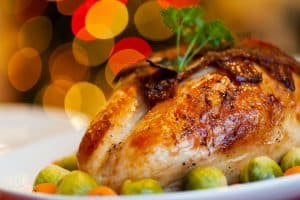
An Easy-to-Make Delicious Holiday Meal Your Family Will Love
This is the season for holiday meals, and the nostalgia and family time spent together at the dinner table. Here at Nourishing Hope, we have readers from 90 countries, who all celebrate the season differently. So whether you are looking for Holiday recipes, or just a fun gluten-free family gathering, here are some of my special diet favorites (all available in Cooking to Heal). Unfortunately for those with food intolerances, the prospect of a Holiday meal rich in gluten and dairy leaves many saying “no thanks!” Traditional stuffing, is made from bread (wheat). Gravy is made with wheat flour, and mashed potatoes are loaded with milk, cream and butter. Pumpkin pie contains wheat and dairy. All of these foods are off limits for those following a gluten-free and casein-free diet (GFCF diet). However, you needn’t miss out on these delicious holiday dishes, nor the good times that accompany the season – not just because you’re on a gluten-free or other allergen-free diet. With a little ingenuity you can maintain the special diet your family is on right through the holidays! Turkey is inherently gluten-free and dairy-free unless you add something containing those ingredients. Use safe herbs and spices, oils, and avoid flour often used as thickener for gravy. Avoid “apple pie spice” and other spice blends in your Thanksgiving dinner (because blends almost always have gluten). Holiday meals often are notoriously deficient on vegetables. Typically there is one “token” vegetable that no one eats. So I’ve included some tasty vegetables that guests will love! In fact, this year my Brussels Sprouts have been requested as an encore, since everyone loved them so much last year. Also, check out this beautiful Kale, Beet, and Pomegranate salad – it’s delicious and the colors are so festive. Most vegetable recipes can be make gluten-free and dairy-free if they are not already, so consider adapting one of your favorites. For mashed potatoes: you can very easily substitute non-dairy milk for milk or cream in the mashed potatoes, and certified casein-free ghee or other fat for the butter, or try my starch-free cauliflower “mashed potatoes.” For a pie, there is no excuse not to do GFCF—there are so many options and no one will know the difference! For those following gluten-free and casein-free, here’s a simple and delicious GFCF Holiday dinner – along with recipes. Trust me, your guests won’t know the difference. If you are following a grain-free and starch-free diet such as GAPS, SCD, or Paleo, simply avoid the stuffing and the crust for the pumpkin pie (just bake the filling alone in the dish), and for the gravy avoid the flour and simply simmer down the pan drippings, and you’ll have a wonderful meal that’s compliant with your special diet.
Gluten-Free/Special Diet Holiday Menu
 Roasted Turkey Gluten-Free Stuffing Gluten-Free Gravy Cranberry Sauce Mashed Cauliflower Potatoes Confetti Brussels Sprouts Kale, Beet and Pomegranate Salad Pumpkin Pie Whether you follow these ideas or create your own meal, with a few new twists on your old classics, you can make an allergy-free Holiday meal that is simple and delicious!
Roasted Turkey Gluten-Free Stuffing Gluten-Free Gravy Cranberry Sauce Mashed Cauliflower Potatoes Confetti Brussels Sprouts Kale, Beet and Pomegranate Salad Pumpkin Pie Whether you follow these ideas or create your own meal, with a few new twists on your old classics, you can make an allergy-free Holiday meal that is simple and delicious!



0 Comments